人教版(2019)必修第二册 Unit4 History and traditions Reading and thinking课件(16张ppt)
文档属性
| 名称 | 人教版(2019)必修第二册 Unit4 History and traditions Reading and thinking课件(16张ppt) | 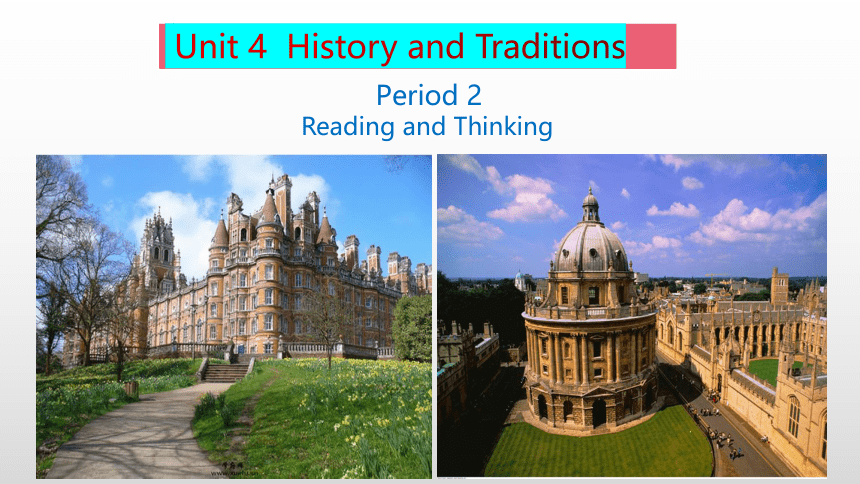 | |
| 格式 | zip | ||
| 文件大小 | 44.9MB | ||
| 资源类型 | 教案 | ||
| 版本资源 | 人教版(2019) | ||
| 科目 | 英语 | ||
| 更新时间 | 2022-12-13 07:50:40 | ||
图片预览

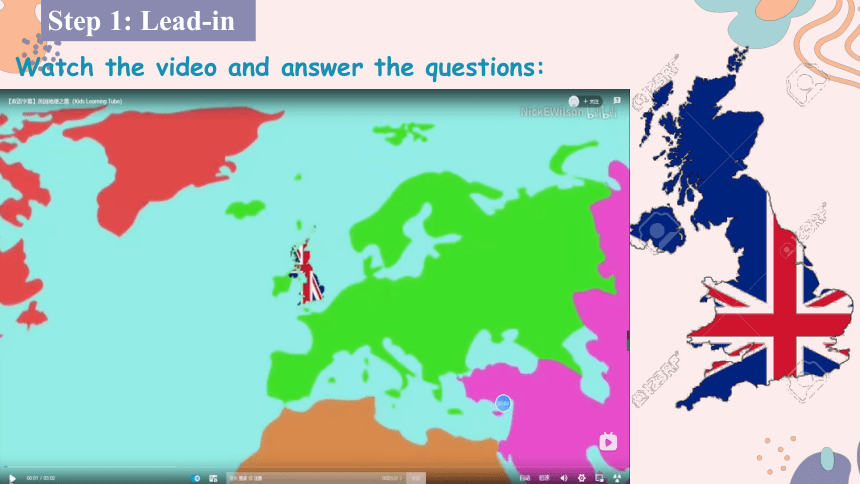
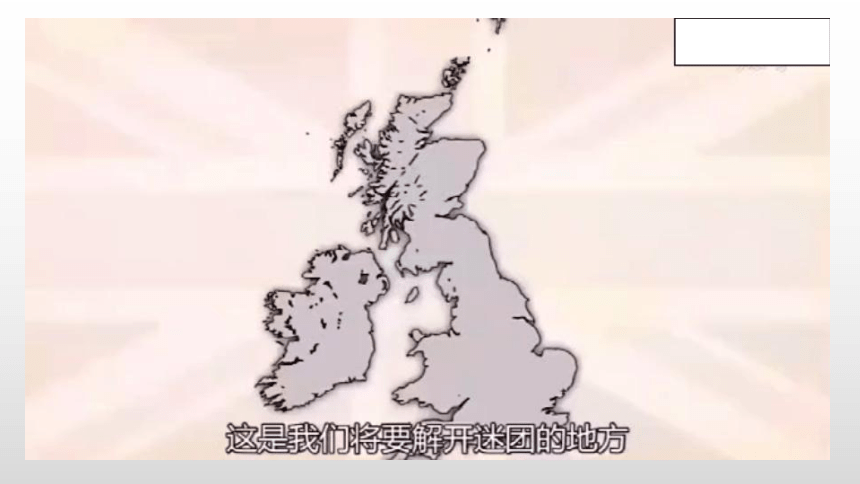
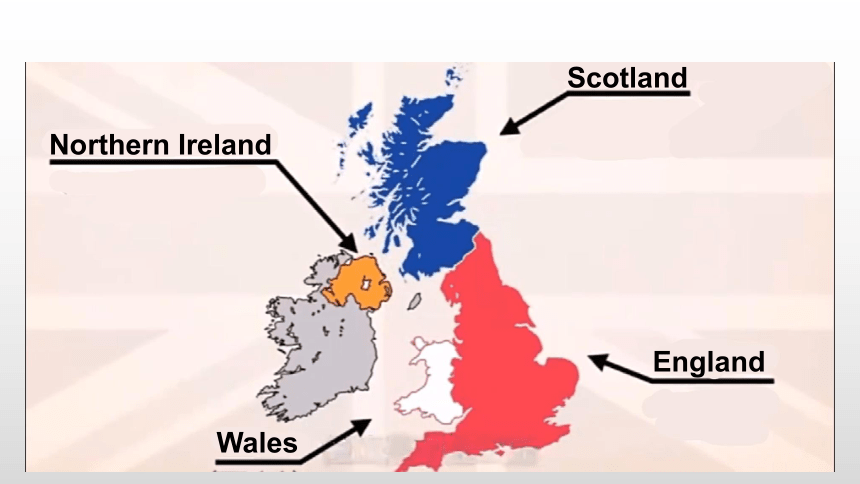
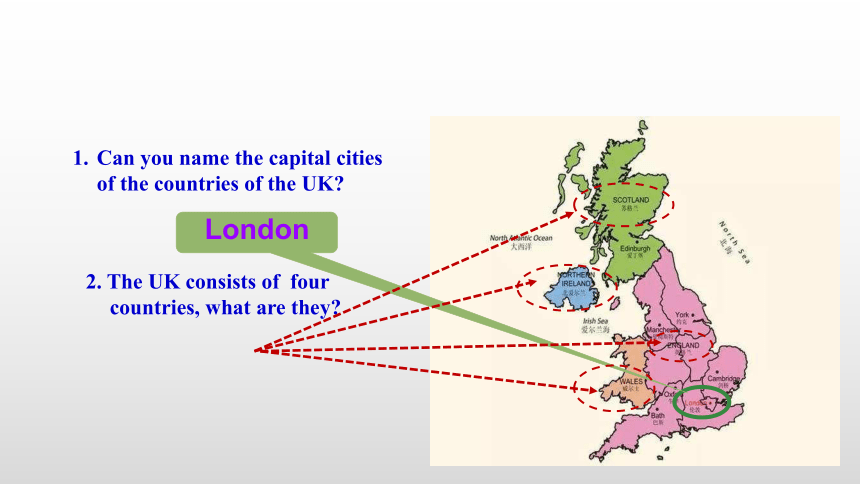
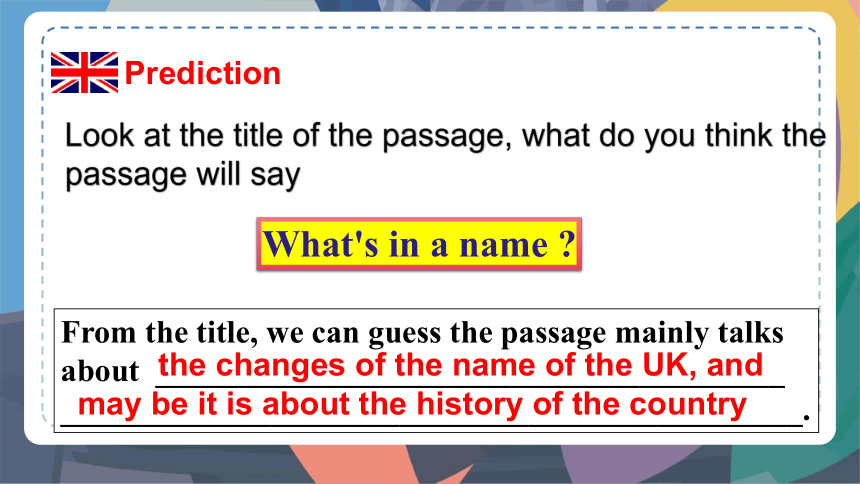
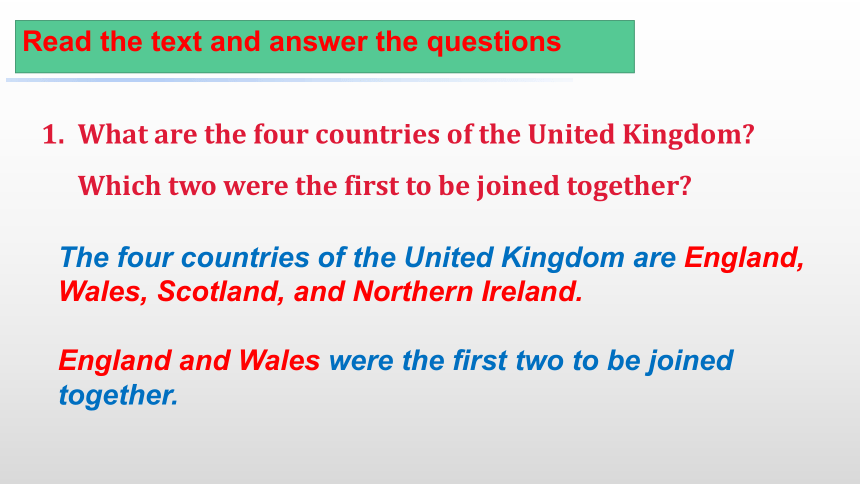
文档简介
(共16张PPT)
Unit 4 History and Traditions
Period 2
Reading and Thinking
Step 1: Lead-in
Watch the video and answer the questions:
England
Scotland
Northern Ireland
Wales
Can you name the capital cities of the countries of the UK
2. The UK consists of four countries, what are they
London
Prediction
What's in a name
From the title, we can guess the passage mainly talks about _______________________________________
______________________________________________.
Look at the title of the passage, what do you think the passage will say
the changes of the name of the UK, and may be it is about the history of the country
Read the text and answer the questions
What are the four countries of the United Kingdom Which two were the first to be joined together
The four countries of the United Kingdom are England, Wales, Scotland, and Northern Ireland.
England and Wales were the first two to be joined together.
Read the text and answer the questions
According to the text, what are two chief advantages of studying the history of a country
To help you understand more about the country and its traditions and to make visiting it more enjoyable.
The national flag
A
B
C
D
Paragraph
Para. 1
Para. 2
Para. 3
Para. 4
Para. 5
Main Ideas
The similarities and differences between four countries within the UK
Learning the country’s history makes your journey more enjoyable
Getting to know British history helps you solve the puzzle
The history of the UK helps us to learn more about the country and traditions
How we get the full name of the country
Match the main idea with each paragraph.
Passage Structure Analysis
the topic
The formation and names of
the UK
The similarities and
differences between
the UK’s 4 countries
The four groups of people in the history of the UK and the changes they brought
The significance of studying the history of a country
England +Wales
England +Wales
+Scotland
(Great Britain)
Great Britain
+ Northern Ireland
Great Britain
+Ireland
in the 16th century
in the 18th century
in the
19th century
be linked to
be joined to
be added to
How did UK come into being
in the
20th century
break away from
Do the four countries work together in all areas
Para3 Similarities and differences
Similarities: _____; ________;________________
Differences: ___________and __________ systems; ___________________ and even______________ for competitions.
currency
flag
military defence
educational
legal
their own traditions
football teams
Reading tip3:
Giving examples (for example; like)can help readers understand the point more easily and more convincing.
Further thinking:
How does the writer develop this paragraph
When What happened What changed
Romans arrived towns and roads
Ango-Saxons came language and the way building house
Vikings came
11th century
16th century
18th century
19th century
20th century name changed to “United Kingdom of Great Britain and Northern Ireland”
1st century
5th century
8th century
Normans conquered England after the Battle of Hastings
Wales was joined to Kingdom of England
Scotland was joined to England and Wales
Ireland was added
the southern part of Ireland broke away
castles built, legal system changed,
and new words from French introduced
“Kingdom of Great Britain” formed
“United Kingdom of Great Britain and Ireland” formed
vocabulary and names of locations across the UK
Read again and finish the timeline chart. --Group work(9mins)
Complete the conversation about the UK using the phrases in their correct forms.
as well as belong to add to join to
break away keep your eyes open
A: I can never remember what the UK means! There's England, Britain,
_________ Great Britain!
B: Well, it helps if you remember that there are four countries
that _________ the UK. That's why it's called the United Kingdom.
A: Four countries I must have been asleep in that part of our history
class! So the first country was England, and the others were
_________ that
B: Yes, right. First England, then Wales, then Scotland. The last country
was Ireland, but later the southern half didn't want to be ________ the
United Kingdom.
A: Oh, I remember now! The southern part __________ from Northern
Ireland, right
B: Yes, you got it well remembered! But __________________ in history
class next time!
as well as
belong to
added to
joined to
broke away
keep your eyes open
Post-reading(15mins)
The United Kingdom, Great Britain,Britain,England- many people________(confuse) by what these different names mean, ________(get) to know a little bit about British history will help you solve the puzzle. From the 16th century to the 19th century,Wales, Scotland and the Kingdom of lreland were joined ________( create) the United Kingdom of Great Britain and lreland. In the 20th century, the southern part of lreland broke away________the UK, ________resulted in the full name:the United Kingdom of Great Britain and Northern lreland. The four countries that belong________the UK work together in some areas. However, they also have some________ ( different).Almost everywhere you go in the UK,you will be surround by evidence of four different groups of people________took over at different times. There is so much more to learn about ________interesting history and culture of the United Kingdom. Studying the history of the country will make your visit much more________(enjoy).
Activity1:Fill in the blanks(5mins)
getting
are confused
to cerat
from
which
to
differences
who
the
enjoyable
Unit 4 History and Traditions
Period 2
Reading and Thinking
Step 1: Lead-in
Watch the video and answer the questions:
England
Scotland
Northern Ireland
Wales
Can you name the capital cities of the countries of the UK
2. The UK consists of four countries, what are they
London
Prediction
What's in a name
From the title, we can guess the passage mainly talks about _______________________________________
______________________________________________.
Look at the title of the passage, what do you think the passage will say
the changes of the name of the UK, and may be it is about the history of the country
Read the text and answer the questions
What are the four countries of the United Kingdom Which two were the first to be joined together
The four countries of the United Kingdom are England, Wales, Scotland, and Northern Ireland.
England and Wales were the first two to be joined together.
Read the text and answer the questions
According to the text, what are two chief advantages of studying the history of a country
To help you understand more about the country and its traditions and to make visiting it more enjoyable.
The national flag
A
B
C
D
Paragraph
Para. 1
Para. 2
Para. 3
Para. 4
Para. 5
Main Ideas
The similarities and differences between four countries within the UK
Learning the country’s history makes your journey more enjoyable
Getting to know British history helps you solve the puzzle
The history of the UK helps us to learn more about the country and traditions
How we get the full name of the country
Match the main idea with each paragraph.
Passage Structure Analysis
the topic
The formation and names of
the UK
The similarities and
differences between
the UK’s 4 countries
The four groups of people in the history of the UK and the changes they brought
The significance of studying the history of a country
England +Wales
England +Wales
+Scotland
(Great Britain)
Great Britain
+ Northern Ireland
Great Britain
+Ireland
in the 16th century
in the 18th century
in the
19th century
be linked to
be joined to
be added to
How did UK come into being
in the
20th century
break away from
Do the four countries work together in all areas
Para3 Similarities and differences
Similarities: _____; ________;________________
Differences: ___________and __________ systems; ___________________ and even______________ for competitions.
currency
flag
military defence
educational
legal
their own traditions
football teams
Reading tip3:
Giving examples (for example; like)can help readers understand the point more easily and more convincing.
Further thinking:
How does the writer develop this paragraph
When What happened What changed
Romans arrived towns and roads
Ango-Saxons came language and the way building house
Vikings came
11th century
16th century
18th century
19th century
20th century name changed to “United Kingdom of Great Britain and Northern Ireland”
1st century
5th century
8th century
Normans conquered England after the Battle of Hastings
Wales was joined to Kingdom of England
Scotland was joined to England and Wales
Ireland was added
the southern part of Ireland broke away
castles built, legal system changed,
and new words from French introduced
“Kingdom of Great Britain” formed
“United Kingdom of Great Britain and Ireland” formed
vocabulary and names of locations across the UK
Read again and finish the timeline chart. --Group work(9mins)
Complete the conversation about the UK using the phrases in their correct forms.
as well as belong to add to join to
break away keep your eyes open
A: I can never remember what the UK means! There's England, Britain,
_________ Great Britain!
B: Well, it helps if you remember that there are four countries
that _________ the UK. That's why it's called the United Kingdom.
A: Four countries I must have been asleep in that part of our history
class! So the first country was England, and the others were
_________ that
B: Yes, right. First England, then Wales, then Scotland. The last country
was Ireland, but later the southern half didn't want to be ________ the
United Kingdom.
A: Oh, I remember now! The southern part __________ from Northern
Ireland, right
B: Yes, you got it well remembered! But __________________ in history
class next time!
as well as
belong to
added to
joined to
broke away
keep your eyes open
Post-reading(15mins)
The United Kingdom, Great Britain,Britain,England- many people________(confuse) by what these different names mean, ________(get) to know a little bit about British history will help you solve the puzzle. From the 16th century to the 19th century,Wales, Scotland and the Kingdom of lreland were joined ________( create) the United Kingdom of Great Britain and lreland. In the 20th century, the southern part of lreland broke away________the UK, ________resulted in the full name:the United Kingdom of Great Britain and Northern lreland. The four countries that belong________the UK work together in some areas. However, they also have some________ ( different).Almost everywhere you go in the UK,you will be surround by evidence of four different groups of people________took over at different times. There is so much more to learn about ________interesting history and culture of the United Kingdom. Studying the history of the country will make your visit much more________(enjoy).
Activity1:Fill in the blanks(5mins)
getting
are confused
to cerat
from
which
to
differences
who
the
enjoyable
